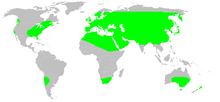Woodlouse spider
| Woodlouse spider | |
|---|---|
 | |
| Scientific classification | |
| Kingdom: | Animalia |
| Phylum: | Arthropoda |
| Class: | Arachnida |
| Order: | Araneae |
| Suborder: | Araneomorphae |
| Family: | Dysderidae |
| Genus: | Dysdera |
| Species: | D. crocata |
| Binomial name | |
| Dysdera crocata C. L. Koch, 1838 | |
 | |
| Synonyms | |
| |
The woodlouse spider, Dysdera crocata, is a species of spider that preys exclusively upon woodlice. Other common names refer to variations on the common name of its prey. These are woodlouse hunter, sowbug hunter, sowbug killer, pillbug hunter and slater spider.
Appearance
Female specimens are 11–15 mm long while males are 9–10 mm. They have a dark-red cephalothorax and legs, and a shiny (sometimes very shiny) yellow-brown abdomen. Notably, they have disproportionately large chelicerae. Dysdera crocata is difficult to distinguish from the much less common Dysdera erythrina[1] though this species is not often found near human habitation.
Distribution
D. crocata, which originated in Europe, now has a cosmopolitan distribution (see map).
Behavior
They are usually to be found under logs in warm places, often close to woodlice. They have been found in houses. They spend the day in a silken retreat made to enclose crevices in, generally, partially decayed wood, but sometimes construct tent-like structures in indents of various large rocks. Woodlouse spiders hunt at night without the use of a web. Their diet consists exclusively of woodlice which—despite their tough exoskeleton—are pierced easily by the spider's large chelicerae.
The courtship of these spiders is typically aggressive and mates risk injury from each other's large chelicerae. The female lays her eggs in a silken sac and is believed to look after her young after hatching like the "Mothercare" spider (Theridion sisyphium).
They have been known to bite humans if handled. Their bite can be painful but the venom causes no major medical problems. Localised itchiness at the bite site has been reported in some cases.[2]
References
- ↑ Cooke, J. A. L. (June 1965), "Systematic aspects of the external morphology of Dysdera crocata and Dysdera erythrina (Araneae, Dysderidae)", Acta Zoologica 46 (1-2): 41–65, doi:10.1111/j.1463-6395.1965.tb00726.x
- ↑ Vetter, R. S.; Isbister, G. K. (2006). "Verified bites by the woodlouse spider, Dysdera crocata". Toxicon 47 (7): 826–829. doi:10.1016/j.toxicon.2006.02.002. PMID 16574180.
External links
- Platnick, Norman I. (2008): The world spider catalog, version 8.5. American Museum of Natural History.
- Pictures of Dysdera crocata (free for noncommercial use)
- Harvard Entomology Bug of the Month - Woodlouse hunter
- Dysdera crocata - GeoSpecies Database University of Wisconsin
- Rodriguez Gil, S. G., L. M. Mola, A. G. Papeschi & C. L. Scioscia (2002). "Cytogenetic heterogeneity in common haplogyne spiders from Argentina (Arachnida, Araneae)" (PDF). Journal of Arachnology 30: 47–56. doi:10.1636/0161-8202(2002)030[0047:CHICHS]2.0.CO;2.
| Wikimedia Commons has media related to Dysdera crocata. |